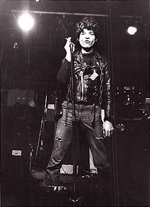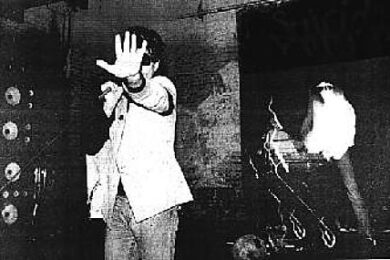Earlier this year, I was invited to take part in a reunion show in New York City, a reunion I had never imagined I would ever sanction. Nearly 29 years to the date of our final performance in Berlin at S.O. 36, Teenage Jesus & the Jerks – the band in which I played bass guitar alongside guitarist/screamer/chief provocateur Lydia Lunch – was briefly re-formed on Friday June 13th 2008.
Our brief reappearance on the musical landscape was prompted by the book launch of No Wave by Byron Coley (former Forced Exposure editor) & Thurston Moore. Teenage Jesus & the Jerks, one of the key bands associated with the “No Wave” genre, seemed to the authors to be the perfect choice to mark the occasion. From my point of view, I couldn’t help but feel that a band that strove to the very apotheosis of austere and unwelcoming negativism shouldn’t be called upon to celebrate anything; rather it seemed more appropriate that Teenage Jesus & the Jerks’ legacy should remain an unapproachable black hole in the musical galaxy.
Nonetheless, seduced by our own morbid curiosity, Lydia resumed the helm on guitar and vocals, I switched from bass guitar to drum (sitting in for the late Bradley Field) and Thurston Moore substituted on bass. In attendance at the show was Marty Rev, the cipher-like, perpetually shaded keyboardist of NY’s legendary but shamefully underrated groundbreaking vocal-keyboard duo Suicide. Asked for his assessment of our show, Rev asserted that it was “authentic”.
Teenage Jesus & The Jerks play ‘Orphans’ at the reunion gig
Marty would certainly know, for Suicide were the only headlining band on the CBGB’s/Max Kansas City circuit back in the late 1970s that would tolerate having a band as extremely anti-entertainment as Teenage Jesus & the Jerks support them. On average a Teenage Jesus & the Jerks set would last only about 12 minutes, but any audience members who caught our act by chance or miscalculation usually wished the set would be even shorter. Our music was eardrum splittingly screechy and brutishly crude but also coolly precise, and our stage demeanor ranged from sneering disdain to sullen hostility.
Marty’s comment zeroed in on the crux of the dilemma that the reunion show posed for myself (and I suspect for Lydia Lunch as well): how could we project the same ratty bratty insouciance that possessed us nearly 30 years ago? In fact, despite Rev’s confirmation, whether we believably recaptured our youthful spunk or not, the context had entirely changed: those dirty NY days of yore were long past and three decades of musical history had raised the threshold of what the public considers musically acceptable.
no band of our ilk can lay claim to provocations of public outrage and antagonism on quite as infamous a scale as Suicide.
Teenage Jesus & the Jerks’ gigs used to boast an average attendance of ten or less; both our sets at the Knitting Factory sold out. People used to keep their distance and show their appreciation with a smattering of desultory clapping or bemused heckling; at the reunion show every song was greeted with a clamoring uproar and sing-a-longs, even a mosh pit at one point. Back in the day, the best we could hope for (and in fact what we usually aimed for) was rejection. For most music fans, we weren’t even on the radar; nowadays we’re just a Google search away.
The No Wave bands posed an largely undetected challenge at the time – not so much to the oblivious status quo and bloated viziers of 1970’s rock industry blandness, as to the clueless protectionism of the press and the smug rebelliousness and parochial elitism of our peers in the then burgeoning punk movement. Perhaps most especially, we cast down a gauntlet to reactionary audience members; but no band of our ilk can lay claim to provocations of public outrage and antagonism on quite as infamous a scale as Suicide.
Suicide’s singer Alan Vega and keyboardist Marty Rev have been inspiring violent reactions, visceral rejection, full scale riots and onstage assaults (including an axe aimed at Vega’s head by an audience member in Glasgow) all through their careers. Though often labeled as such, Suicide had really nothing to do with No Wave or Punk; they stand virtually alone, but have inspired many. Their initial live appearances date unbelievably all the way back to 1971; a flier for one of their earliest gigs lends credence to the possibility that they were the very first band to describe their music as “punk”. Their music however was not Punk as we’ve come to know it.

Apart from LA’s The Screamers, Suicide’s reliance on keyboards as the sole instrument was unheard of for guitar-centric Punk rock. On the other hand, the duo format they adopted was unusual, but not unheard of: obscure bands like Silver Apples and Red Transistor were utilizing a stripped down line-up as part of their respective aesthetic strategies to challenge entrenched rock preconceptions. At the other end of the spectrum, there was Lee Michaels, who played Hammond organ accompanied only by his drummer Frosty; they enjoyed a brief commercial success with the hit ‘Do You Know What I Mean?’
The “instrumental” difference between Suicide and all the aforementioned bands is that they all retained a live drummer as part of their line-ups. Suicide took the concept and application of a minimalist combo several steps further. They not only eliminated the drummer, they deconstructed the very function of the drummer’s doppelganger, the dreaded rhythm machine. In those days, rhythm machines were mostly employed as a primitive but expedient accessory to cocktail lounge entertainers, providing politely generic renditions of outdated dance crazes like the waltz and cha-cha-cha.
Suicide live
In Suicide’s hands, rather than providing the simple dance beats these machines were typically known and despised for, their treatments rendered drum box beats and sounds almost unrecognizable. The churning industrialised pulses, eerie insect drones, and sinister shimmering wavelike textures Suicide utilised were undeniably rhythmic, yet defied dance floor interpretation; not so much backbeat, as backdrop for Rev’s mesmeric tonal platforms and Vega’s psycho-dramatics.
Grinderman (of my many other bands) invited Suicide to support us at the Forum in London last year. To this day, people unacquainted with Suicide’s art and legacy ask me “What the fuck was that all about? They were bloody awful!” It can only be to Suicide’s credit that at their advanced ages (Alan recently celebrated his 70th birthday, not 60th as inaccurately stated in Wikipedia) they are still “authentic” in their own right, still polarizing unsuspecting audiences with their formidable and uncompromising sonic assault, still testing the utmost limits of how the critical masses define music.
Teenage Jesus & The Jerks Shut Up & Bleed is out now. Suicide’s box set Live 1977-1978 is out now. Read the Quietus review of Suicide Live 1977-1978.



